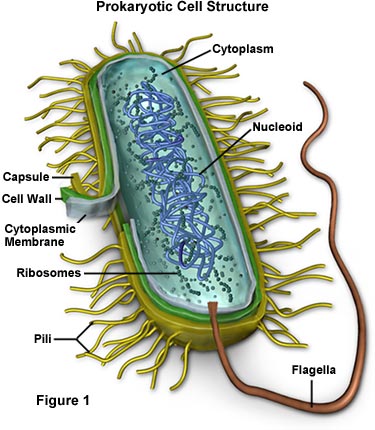Structure of bacteria:
Bacteria are prokaryotic, unicellular organisms. They divide by binary fission (asexual), conjugation and plasmid. The outer layer of a bacterial cell consists of two components- a rigid cell wall and underlying cytoplasmic membrane or plasma membrane. Inside the outer covering, lies protoplasm comprising of cytoplasm (ribosomes, inclusion granules, mesosomes) and a circular DNA. Some bacteria may possess additional gelatinous covering outside the cell wall known as capsule. Apart from this, some bacteria bear filamentous structures protruding from cell surfaces (flagella, fimbria).

a. Cell wall:
It is a tough rigid structure and provides shape to the bacteria. It is elastic and porous and is freely permeable to solutes (<10000 molecular weight). Cell wall does not stain with simple stains and cannot be seen by direct light microscopy. The cell wall takes part in cell division by forming an in-growth. The mucopeptide component of cell wall possesses target site for antibiotics, lysozymes and bacteriophages.
The rigid component of cell wall is made of peptidoglycan. It is present in cell wall of both gram positive and gram negative bacteria but more abundant in gram positive bacteria. Chemically, peptidoglycan is composed of carbohydrates N- acetyl glucosamine and N- acetyl muramic acid molecules which are cross- linked by short peptide chains.
The peptidoglycan in most gram positive bacteria is covalently linked to teichoic and lipoteichoic acids. Certain gram positive cell walls also contain antigens such as the polysaccharide and protein.
In gram negative cell, there is a periplasmic space immediately outside the cytoplasmic membrane that contains degradative enzymes and specific binding and transport proteins for amino acids, vitamins, and ions. Outer to the periplasmic space, there is thin peptidoglycan layer (hence more susceptible to physical damage). Outside the peptidoglycan layer is the outer membrane. It is found only in gram negative bacteria. It is a basic structure similar to phospholipid bilayer that contains various embedded lipopolysaccharides (LPS) and various proteins.
b. Cytoplasmic membrane:
It is a thin, elastic semi-permeable layer lies just beneath the cell wall. Chemically, the membrane consists of phospholipid bilayer with small amount of carbohydrates. The lipid molecules are arranged in a double layer with their hydrophilic polar regions externally aligned and in contact with a layer of protein on each surface.
c. Cytoplasm: contains water, enzymes, ribosomes, circular DNA, plasmid.
d. Circular DNA: It is the genetic material.
e. Capsule and glycocalyx: Some bacteria surrounded by polysaccharide layer called capsule. Protects the bacteria and help in colony stabilization.
f. Flagella: Thin rigid filament which allows movement.
g. Pili: Hair like structures that help in attachment to mucosal surfaces, involve in bacterial conjugation by forming bridge.